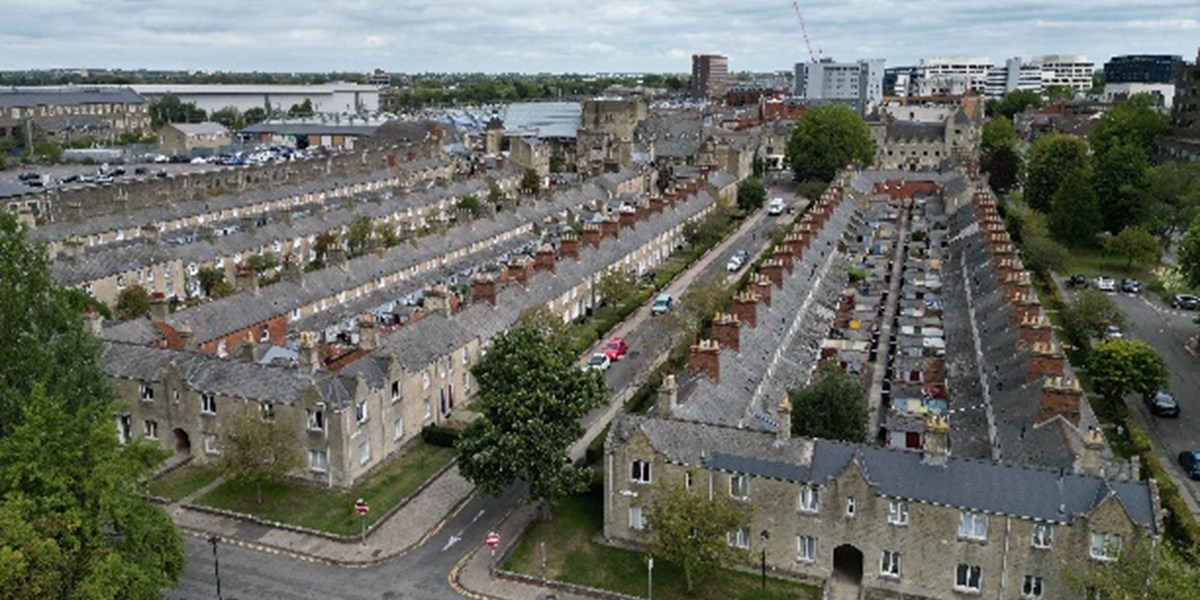
Image source: Swindon Borough Council
Sarah Peña, head of emerging technology and business improvement at Swindon Borough Council, describes the benefits that have emerged from its use of drones in supporting maintenance of the housing stock
Modernisation in the field of social housing is often marked by the creation of intangible benefits that go far beyond mere cost savings and operational efficiency.
One such example is the introduction of drones for our social housing roofing inspections, an imaginative move supported by a dedicated collaborative team of cross-council services committed to enhancing how we support our tenants and improve efficiency of operations. This blog delves into the benefits we’ve seen.
Before we explore the outcomes, it's essential to acknowledge the effort invested upfront. I spent a considerable amount of time thinking about and researching potential concerns and barriers to acceptability then devising strategies to mitigate them.
The focus on governance and openness of this was paramount, laying the foundations for success. Right from day one, we implemented nudge theory and went with an active opt-in approach, setting the stage for a paradigm shift in inspections.
Drones have played a pivotal role in enhancing transparency and trust. They offer a visual layer of transparency in the inspection process, allowing residents (and interested near bystanders) to witness assessments first-hand.
This not only fostered trust in the council's commitment to their wellbeing but also initiated conversations about technology adoption and urban improvements. The result? A stronger sense of community involvement and shared vision.
Safety priority
The safety of staff and residents was a top priority. With drones, staff members are provided with a safer work environment, significantly reducing the risk of accidents and injuries. The team also gained the ability to identify hazardous materials upfront, mitigating potential dangers and delays.
Moreover, drones have reduced risk in several other areas; for example, the risk of children climbing scaffolding (it happens), decreased issues associated with property access (especially for older individuals and those with physical disabilities), and reduced risk in property damage.
One of the most significant benefits emerged in the form of workforce happiness, skills acquisition and new opportunities. The staff developed new skillsets, leading to enhanced professional growth, job satisfaction, and motivation; they have a real sense of pride in how they’ve collaborated and developed with us a modernised approach for their work.
Notably, private property owners have inquired about the drone service, opening up future income potential for the council.
Residents' interest
The introduction of drones has sparked curiosity and discussions among residents, stimulating interest in technology adoption and urban improvements.
In turn, this has fostered a sense of community involvement and collaboration. Residents recognise that drones are contributing to more eco-friendly practices by reducing or eliminating the need for scaffolding and unnecessary additional travel, which aligns with the council’s broader sustainability goals and resonates positively with environmentally conscious residents.
The feedback from tenants has been overwhelmingly positive: 94% positively responded to drones being used for social housing roof inspections This demonstrates the strong voice and trust of the tenants in the council's initiative and that the hard work on engagement, transparency in approach, actively seeking opt-in and governance was so important.
We’re now a year on from our trial and the use of drones has revealed fantastic results. We have shortened the average scaffolding hire time by 45%, and there have been no cases where additional work has been required if it was done after a drone inspection, meaning right first-time repairs.
In 4% of cases, drones are identifying non-roofing issues, completely avoiding the need for scaffolding and any working from height. A further 4% are identifying hazardous materials, allowing the specialist team to act promptly. The financial benefits are also substantial: we’re seeing annual savings of £80,265.00. And the average inspection time with drones is just 17 minutes, a stark contrast to the previous 64 days.
Extending usage
Drones have now become business as usual for the roofing teams. All teams are fully qualified, with each one having their own drone, ensuring the sustainability and continuity of this initiative. Additionally, we’ve now extended our use of drones across the council, bringing wider business benefits.
This was all made possible thanks to the collaborative efforts of teams from operations to housing, health and safety, audit, web, communications, customer services, and my emerging tech team, along with, all importantly, engaged and supportive tenants and residents. Their collective wisdom, wide range of perspectives and experiences, along with dedication were crucial to the success.
The tangible benefits are evident, and the intangible rewards in terms of safety, trust, empowerment, sustainability, and community engagement are equally, if not more, compelling. This work exemplifies how forward thinking initiatives and collaboration can transform how we work with and support our communities, residents and town, who are at the heart of all we do.
If you want to continue the conversation or share your thoughts, please feel free to reach out to emergingtech@swindon.gov.uk





